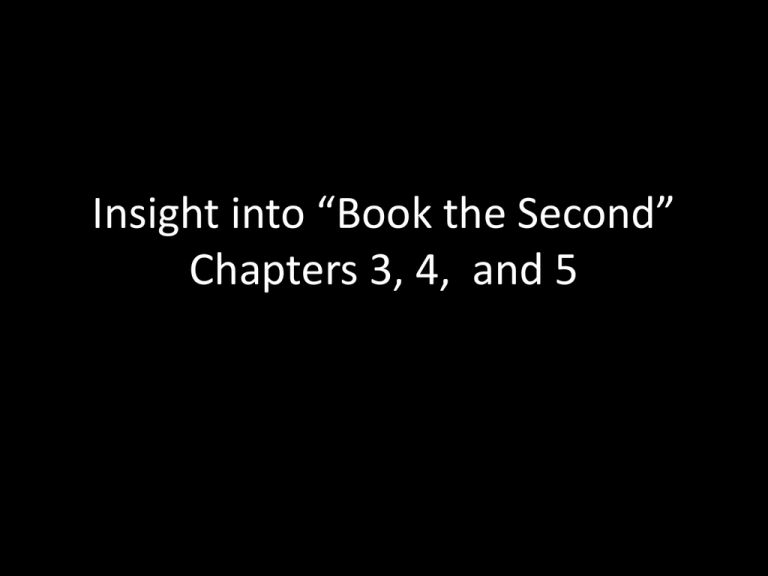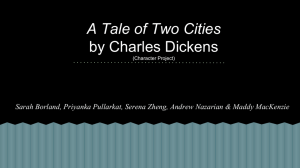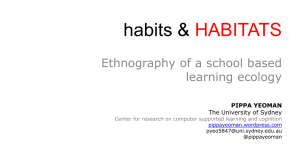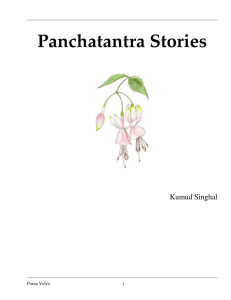A Tale of Two Cities: Chapters 3-5 Study Guide
advertisement

Insight into “Book the Second” Chapters 3, 4, and 5 Chapter 3: “A Sight” Literary Foils *A character foil is a character whose traits are in direct contrast to those of another character. These two characters are juxtaposed to highlight each other’s differences. Make sure that you have marked Sydney Carton’s first appearance on page 62 and Charles Darnay’s first appearance on page 63—and note that Dickens establishes their role as foils from their first appearances. Continue to look for these differences, marking them in chapter 4. Be sure that you can explain why Chapter 3 is entitled “A Disappointment.” (In other words, what is the disappointment? Who is disappointed?) Dickens satirizes the British court system on pp. 66-69 through the use of hyperbolic jargon. Be sure that you can explain the metaphor of the “blue flies” and their buzzing in chapter 3. Chapter 4: Congratulatory • Make sure that you can explain why chapter 4 is entitled “Congratulatory.” • At the bottom of p. 81, note the irony of Mr. Stryver telling Charles that he was “glad to have brought [him] off with honour”—when in actuality Sydney is responsible for saving Charles’ life. • On page 81, we see Dr. Manette looking at Charles in a strange manner (see the “His face had become frozen” paragraph). Mark this as foreshadowing. • As Sydney takes Charles out for a congratulatory drink after the trial, mark every evidence of these two being foils for one another. Chapter 5: “The Jackal”—BEFORE READING Keep in mind that no title in a Dickens’ chapter is insignificant. As you read, keep in mind the definition of “jackal” that I’ve given on the next slide. Be prepared to explain who the “jackal” is—and what irony is involved in that title. Jackal denotation: dog-like animal from Africa/Asia connotation: one who performs tasks for another Chapter 5: “The Jackal”—BEFORE READING Charles and Sydney are not the only foils in A Tale of Two Cities. Stryver and Sydney are foils. Be ready to explain how their characters are opposite one another. Chapter 5: “The Jackal”—DURING READING Paragraph 1, page 86: Remember that you already know what the word “Bacchanalian” means because of our study of Antigone. Bacchus is the same GrecoRoman God as Dionysus (the Greek wine and fertility). So, the term “Bacchanalian” now brings to mind the image of a drunken revelry. Chapter 5: “The Jackal”—DURING READING Paragraph 1, page 86: Note the pun and the symbolism of the lawyer’s name: Stryver (a striver is one who strives). In this paragraph, the narrator tells us that this man is “already fast shouldering his way to a large and lucrative practice.” (Remember what Brutus said about lowliness being “young ambition’s ladder”? Stryver is using Sydney to climb his way up the ladder of success—and he’s forgetting that Sydney is the one getting him to that success.) Chapter 5: “The Jackal”—DURING READING Page 87: Notice the characterization of Sydney Carton as an alcoholic. (See “Sydney Carton” paragraph.) Chapter 5: “The Jackal”—DURING READING Page 88-89: The jackal imagery is implemented here. Notice what Sydney is doing for Stryver—and what Stryver is doing what Sydney does the work! Chapter 5: “The Jackal”—DURING READING Page 92: Notice the sad imagery of the last paragraph of Chapter 5. Be sure that you understand the “sad” physical setting is reflecting the sad state of Sydney Carton (and be sure you can explain why Sydney’s condition is sad). Dickens often has his physical setting reflect the mood of the characters or the conflict of the drama.








